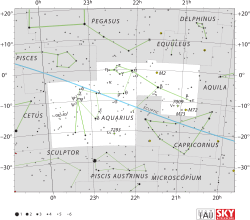Kappa Aquarii

| |
| Observation data Epoch J2000 Equinox J2000 | |
|---|---|
| Constellation | Aquarius |
| Right ascension | 22h 37m 45.38049s[1] |
| Declination | –04° 13′ 40.9939″[1] |
| Apparent magnitude (V) | 5.03[2] |
| Characteristics | |
| Spectral type | K2 III[3] |
| U−B color index | +1.16[2] |
| B−V color index | +1.142[4] |
| Astrometry | |
| Radial velocity (Rv) | +7.31 ± 0.16[4] km/s |
| Proper motion (μ) | RA: –69.23[1] mas/yr Dec.: –119.67[1] mas/yr |
| Parallax (π) | 15.25 ± 0.21[1] mas |
| Distance | 214 ± 3 ly (65.6 ± 0.9 pc) |
| Details | |
| Radius | 13[4] R☉ |
| Luminosity | 60[4] L☉ |
| Surface gravity (log g) | 2.5[4] cgs |
| Temperature | 4,581[4] K |
| Metallicity [Fe/H] | +0.14[4] dex |
| Rotational velocity (v sin i) | 3.8[4] km/s |
| Other designations | |
Kappa Aquarii (κ Aquarii, abbreviated Kappa Aqr, κ Aqr), also named Situla,[6] is a double star in the equatorial constellation of Aquarius. This system is visible to the naked eye, but it is faint at an apparent magnitude of 5.03.[2] Based upon parallax measurements made during the Hipparcos mission, it is around 214 light-years (66 parsecs) from the Sun.[2]
Nomenclature
κ Aquarii (Latinised to Kappa Aquarii) is the system's Bayer designation.
It bore the traditional name Situla, a Latin word meaning "bucket" or "water jar".[7] In 2016, the International Astronomical Union organized a Working Group on Star Names (WGSN)[8] to catalogue and standardize proper names for stars. The WGSN approved the name Situla for this star on 12 September 2016 and it is now so entered in the IAU Catalog of Star Names.[6]
In Chinese, 虛梁 (Xū Liáng), meaning Temple, refers to an asterism consisting of Kappa Aquarii, 44 Aquarii, 51 Aquarii and HD 216718.[9] Consequently, Kappa Aquarii itself is known as 虛梁三 (Xū Liáng sān, English: the Third Star of Temple.).[10] From this Chinese name, the name Heu Leang has appeared, meaning "the empty bridge".[7]
Namesake
USS Situla (AK-140) was a United States Navy Crater class cargo ship named after the star.
Properties
Kappa Aquarii is most probably a wide binary star system.[11] The brighter component is a giant star with a stellar classification of K2 III.[3] It has exhausted the supply of hydrogen at its core and has expanded to 13[4] times the radius of the Sun. It is radiating 60[4] times the Sun's luminosity from its outer envelope at an effective temperature of 4,581 K,[4] giving it the orange-hued glow of a K-type star.[12]
The fainter companion star is located at an angular separation of 98.3 arcseconds and has an apparent magnitude of 8.8.[12]
In culture
Endymion, an 1818 poem by John Keats, describes the star in its form as a water urn thus:
Crystalline brother of the belt of heaven,
Aquarius! to whom King Jove has given
Two liquid pulse streams 'stead of feather'd wings,
Two fan-like fountains, — thine illuminings.[1]
References
- 1 2 3 4 5 van Leeuwen, F. (November 2007), "Validation of the new Hipparcos reduction", Astronomy and Astrophysics, 474 (2): 653–664, arXiv:0708.1752
 , Bibcode:2007A&A...474..653V, doi:10.1051/0004-6361:20078357.
, Bibcode:2007A&A...474..653V, doi:10.1051/0004-6361:20078357. - 1 2 3 4 Nicolet, B. (1978), "Photoelectric photometric Catalogue of homogeneous measurements in the UBV System", Astronomy and Astrophysics Supplement Series, 34: 1–49, Bibcode:1978A&AS...34....1N.
- 1 2 Buscombe, W. (1962), "Spectral classification of Southern fundamental stars", Mount Stromlo Observatory Mimeogram, 4, Bibcode:1962MtSOM...4....1B.
- 1 2 3 4 5 6 7 8 9 10 11 Massarotti, Alessandro; et al. (January 2008), "Rotational and Radial Velocities for a Sample of 761 HIPPARCOS Giants and the Role of Binarity", The Astronomical Journal, 135 (1): 209–231, Bibcode:2008AJ....135..209M, doi:10.1088/0004-6256/135/1/209.
- ↑ "kap Aqr -- Star in double system", SIMBAD Astronomical Object Database, Centre de Données astronomiques de Strasbourg, retrieved 2012-07-01.
- 1 2 "IAU Catalog of Star Names". Retrieved 28 July 2016.
- 1 2 Allen, Richard Hinckley, Star Names — Their Lore and Meaning: Aquarius (Dover ed.), retrieved 2012-07-01.
- ↑ IAU Working Group on Star Names (WGSN), International Astronomical Union, retrieved 22 May 2016.
- ↑ (Chinese) 中國星座神話, written by 陳久金. Published by 台灣書房出版有限公司, 2005, ISBN 978-986-7332-25-7.
- ↑ (Chinese) 香港太空館 - 研究資源 - 亮星中英對照表, Hong Kong Space Museum. Accessed on line November 23, 2010.
- ↑ Eggleton, P. P.; Tokovinin, A. A. (September 2008). "A catalogue of multiplicity among bright stellar systems". Monthly Notices of the Royal Astronomical Society. 389 (2): 869–879. arXiv:0806.2878
 . Bibcode:2008MNRAS.389..869E. doi:10.1111/j.1365-2966.2008.13596.x.
. Bibcode:2008MNRAS.389..869E. doi:10.1111/j.1365-2966.2008.13596.x. - 1 2 "The Colour of Stars", Australia Telescope, Outreach and Education, Commonwealth Scientific and Industrial Research Organisation, December 21, 2004, retrieved 2012-01-16.